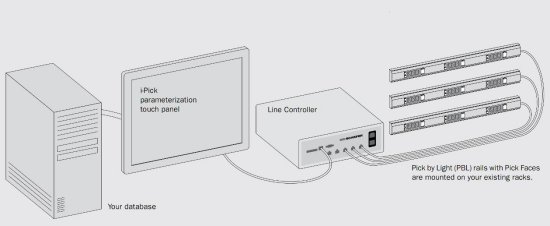Pick-by-light system implemented in a panel PC
Monday, 31 January, 2011
In both the warehouse and assembly industries, the process of order picking is one of the most labour-intensive functions. In fact, it can account for up to 50% of the labour budget. Because of this, companies are constantly searching for ways to improve this process in order to maximise productivity and meet rising customer expectations. There are three main factors that come into play when looking to improve order picking. The first is the productivity or ‘pick rate’; the second, the amount of time it takes to get an order from order entry to the shipping dock, also called the ‘cycle time’; and lastly, the accuracy of the picks.
Various systems are available to improve all of these factors. However, most of those systems include technology such as barcodes and RFID tags or feature voice recognition; technologies that are usually oversized for smaller warehouses and assemblies. These systems tend to be only useful for larger warehouses maintaining more complex supply chains including traceability. Therefore, for smaller warehouses, alternative solutions needed to be found.
|
One cost-effective system for smaller warehouses and assemblies (which not only increases accuracy but also productivity) is a pick-by-light solution (PbL). A PbL system consists of lights and LED displays for each pick location. Software is used to light each item to be picked and to display the quantity needed to be picked. After picking the item, the user presses the lit button indicating that the item has been picked. The system then lights each successive item to be picked until the complete order has been filled. When looking for the optimum PbL solution to develop, this is the type of system SSI Schäfer decided on. In general, most PbL systems must be accessed directly from the warehouse database server. Therefore, the implementation of the decentralised GUIs is more the responsibility of the ERP system provider. |
|
SSI Schäfer’s goal was to develop a PbL system that could interact with all standard ERP systems or warehouse databases via standard interfaces and have its own intelligence to manage the data transfer to both the PbL logic and the various ERP systems. By having its own logic, setting up a PbL system can be carried out in a more convenient and efficient way. In the past, this would have been a costly proposition compared to installing thin clients because more PC performance is required for such installations. However, in recent years, such systems based on small form factor x86 processors such as Intel Atom processors have become much more affordable. So SSI Schäfer opted for touch panel technology in a small, compact and lightweight design. “The usability of the system should be as easy and intuitive as a navigation system and no user interface devices should be needed for handling and configuration,” said Markus Schlagbauer, Group Leader for R&D control engineering at Schäfer.
The i-Pick system consists of three main components: pick-by-light (PBL) rails with pick faces; the line controllers that can handle up to 200 pick faces; and the panel PC that is the central user interface that is usually in direct interaction with a central SQL database, serving XML data files via USB, wireless or wired LAN.
To simplify development and order procedures, SSI Schäfer required an application-ready x86 system that could be ordered and preconfigured from a single vendor. The system should be small and light, to allow for easy installation and manoeuvrability. In addition, the device should feature a fanless design, with no moveable parts in order to maximise MTBF. In the end, Schäfer decided on the Kontron Medi Client 150.
|
|
For the operating system, Schäfer chose to go the open source route with Ubuntu Linux. Their software application was completely developed in house and implemented a front-end GUI for user friendliness. The system needed support for this operating system. Not all hardware vendors have experience in this field or have chosen to solely focus on a commercial environment only. So SSI Schäfer needed to find a vendor that was OS independent and is also active in the further developments of open source software.
For the processor technology, SSI Schäfer was looking for a platform utilising an AMD Geode processor and a 1 GB compact flash drive. This processor enables passive cooled systems, and the housing of the Kontron Medi Client is formed from moulded plastic, making the entire system more cost effective and lighter compared to standard industrial computers. At the same time, the system has long-term availability and is also rugged, with features like IP65 protection from dust and contaminants.
“The system is rugged and IP protected, yet light and long-term available. Due to its medical conforming design, it has very good occupational safety combined with a cost-effective housing that is, in the majority of cases, not offered for such embedded systems due to its more common usage in non-industrial-grade applications,” Schlagbauer remarks. “Also, the fact that the system we required was already available as an application-ready system platform including all driver support required for our Ubuntu application was of great advantage. It allowed us to bypass system adaptation and focus instead on building our application.”
The environmental impact of AI: a help or hindrance for industry?
AI offers powerful tools to improve sustainability in water, waste and energy systems, but its...
Securing industrial networks: three architecture strategies
The goal of industrial cybersecurity is to enhance existing architectures with layered, pragmatic...
Digital integration in mining: from engineering to operations
Rising demand for critical metals is driving operators to adopt digital platforms to build...









